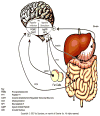Development of eating behavior: biology and context
- PMID: 22472944
- PMCID: PMC3426439
- DOI: 10.1097/DBP.0b013e31824a7baa
Development of eating behavior: biology and context
Abstract
Eating is necessary for survival, gives great pleasure, and can be perturbed leading to undernutrition, overnutrition, and eating disorders. The development of feeding in humans relies on complex interplay between homeostatic mechanisms; neural reward systems; and child motor, sensory, and socioemotional capability. Furthermore, parenting, social influences, and the food environment influence the development of eating behavior. The rapid expansion of new knowledge in this field, from basic science to clinical and community-based research, is expected to lead to urgently needed research in support of effective, evidence-based prevention and treatment strategies for undernutrition, overnutrition, and eating disorders in early childhood. Using a biopsychosocial approach, this review covers current knowledge of the development of eating behavior from the brain to the individual child, taking into account important contextual influences.
Conflict of interest statement
Figures


References
-
- Inui A, Asakawa A, Bowers CY, Mantovani G, Laviano A, Meguid MM, et al. Ghrelin, appetite, and gastric motility: the emerging role of the stomach as an endocrine organ. FASEB J. 2004;18:439–56. - PubMed
-
- Margetic S, Gazzola C, Pegg GG, Hill RA. Leptin: a review of its peripheral actions and interactions. Int J Obes Relat Metab Disord. 2002;26:1407–33. - PubMed
-
- Konner AC, Klockener T, Bruning JC. Control of energy homeostasis by insulin and leptin: targeting the arcuate nucleus and beyond. Physiol Behav. 2009;97:632–8. - PubMed
-
- Mutt V. Historical perspectives on cholecystokinin research. Ann N Y Acad Sci. 1994;713:1–10. - PubMed
-
- Dockray GJ. Cholecystokinin and gut-brain signalling. Regulatory Peptides. 2009;155:6–10. - PubMed

